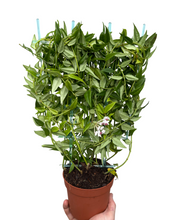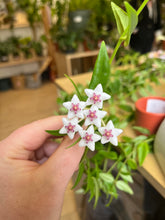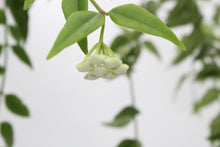Hoya bella (syn. Hoya lanceolata subsp. bella) is part of the Apocynaceae family and it’s native range is Assam (Manipur) to Myanmar. This is a pendant Hoya known to be a prolific bloomer, it has small lanceolate leaves, they’re not as succulent as other Hoya so it’s best to keep the potting mix evenly moist. It has a flat topped umbel with between 6 and 10 flowers, they’re white with a pink-purple corolla.
Thomas Lobb originally collected the plant in 1846 and it was first described in 1848 in Curtis’s Botanical Magazine by William Hooker, he named it Hoya bella.
Genus name is new Latin, named after Thomas Hoy ( c. 1750– c. 1821), English gardener. Specific epithet comes from the Latin meaning ‘beautiful’.
Pot: ø 12cm.
Height from base of pot: Approximately 25cm.
Light: Bright indirect light, meaning the plant sees the sun for 0-4 hours per day - this could be through trees or a translucent curtain, it’s important for the plant to see the sky in order to thrive. More hours of light are thought to encourage flowering.
Many people keep Hoya bella in north-east or east facing windows.
Water: Given adequate light, allow the mix to dry out a little. If your Hoya is potted in a chunky, fast draining mix, you may need to water more frequently.
Potting mix: A chunky well-draining mix composed of coco coir, perlite or vermiculite, orchid bark, worm castings and some horticultural charcoal. I also recommend potting Hoya in coco chips.
Fertilising: Feed your plant every few waterings during the growing season or when you observe active growth. You can dilute fertiliser to half the recommended amount but never add more.
Temperature: 12-25˚C.
Humidity: Hoya would prefer higher humidity, between 60-80% but do well to adapt to average home humidity. You can increase humidity by placing the plant on a watered pebble tray or using a humidifier.
Hoya aren’t considered toxic, however, they may make your pet or child vomit if ingested, keep out of reach just to be safe.





